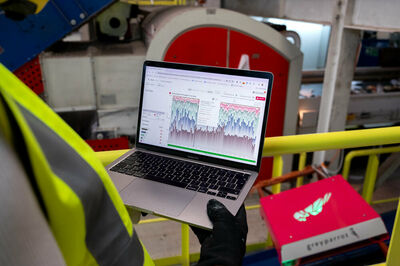Artificial Intelligence : Greyparrot’s COO Gaspard Duthilleul on how AI is revolutionizing waste management: “The technology can already do it!”

The main thing about AI is that it collects data; huge amounts of it. It processes a lot of images much faster and on a much bigger scale than traditional technology. The collected and analysed data thus creates a feedback loop, say in a waste sorting or recycling facility enabling the operator to modify processes. Everything can be analysed: from waste stream to material composition. From peak times to down times.
Of course, optimizing plant operations requires a deep understanding of the data. “Through our Greyparrot’s Analyzer, we make the data as actionable as possible. Nevertheless, you need someone capable of reading and interpreting the analytics to boost performance,” explains Greyparrot’s Chief Operating Officer, Gaspard Duthilleul. This leads to a crucial point in the digitalization process: the shift in mindset—and in workforce requirements. In an AI-supported waste management plant, an entirely new skill set is essential. “AI creates different jobs; it upskills the workforce,” Duthilleul asserts. He also emphasizes that AI cannot function independently. “Everything is based on human experience and expertise.”
In working with their clients Greyparrot combines a data-based approach with consulting, as Duthilleul clarifies: “We work intensively with our clients to understand what would be most beneficial for them.” Whether that involves robots, optical sorters or basic separators, all solutions benefit from AI-driven technologies such as computer vision, object detection models, and machine learning.
AI creates different jobs; it upskills the workforce.Gaspard Duthilleul, COO of Greyparrot
“The technology can already do it”
While all waste streams benefit from AI, some see even greater improvements—especially those that are notoriously tricky to sort. Take food-grade plastics, for example. Traditional optical sorters struggle to differentiate between them, but AI-driven solutions using RGB cameras, which mimic human vision, are changing that. The same goes for black and opaque plastics—materials that standard optical sorters often misclassify or overlook entirely. AI-enriched sorting is stepping in to fill these gaps, making recycling more precise and efficient.
“Today, in many cases, the technology can already do it,” says Duthilleul. “If not, you can push technology providers to figure out how to do it because technology is evolving fast! While plastic is one of the most urgent recycling challenges, waste AI providers are expanding their focus to sectors like construction and demolition, electronics and textiles, which create massive amounts of waste."
But here’s the catch: AI's evolution isn’t the only factor at play. The real challenge is demand. Even if AI can sort materials like black plastic or separate polypropylene into white, clear, and coloured streams, the question remains — does the industry actually want these new streams? Is there a market for them?

Striving for maximum efficiency
Recycling is evolving differently around the world. Europe and the UK are pushing for high recycling rates through stricter regulations, while North America – though less regulated – is investing big in high-tech sorting centres. In South Korea, the focus is on ultra-pure plastic recycling, and countries in South America, Asia, and Africa are starting to show interest in data-driven waste management. No matter the region, one thing is clear: businesses know that better recycling isn’t just about regulation. It’s about efficiency, profitability and sustainability. Even though sustainability and recycling rates are not high on the agenda of the current US administration, for example, the private sector is moving things forward. Consumer demand and the valuable commodities on offer in waste streams are incentive enough.
The future is adaptable
Although Greyparrot AI is already helping recovery facilities in over 20 countries maximise efficiency, Duthilleul believes we are still at an early stage –especially when talking about predictive maintenance, automated change and dynamic adjustments.AI is starting to automate more of the sorting process, allowing plants to dynamically adjust based on material composition, market demand, or even sustainability goals. Advanced systems can shift sorting priorities in real time—like a Greyparrot partner in South Korea, where AI-driven robots adjust based on incoming waste data. This flexibility not only maximizes efficiency and value recovery but also enables sorting plants to optimize for factors like carbon emissions and landfill diversion. “I think within the next five years, we will see the development of smart, automated and autonomous sorting centres,” predicts Duthilleul.
One major challenge he highlights is the lack of communication along the value chain – from producers down to recyclers and waste managers. “We are telling packaging producers that products designed to be unique are not necessarily circular. Will they be recyclable? Will they even be sortable? Only a holistic approach can lead to a circular economy.” AI might just be the tool to enable this transformation.
In cooperation with Greyparrot
Discover the potential of food-grade polypropylene recovery in Greyparrot's latest report, What’s in a Bale? Developed with Closed Loop Partners, the NextGen Consortium, and waste sector experts, this AI-powered analysis reveals new opportunities to reclaim valuable materials from the recycling stream.

